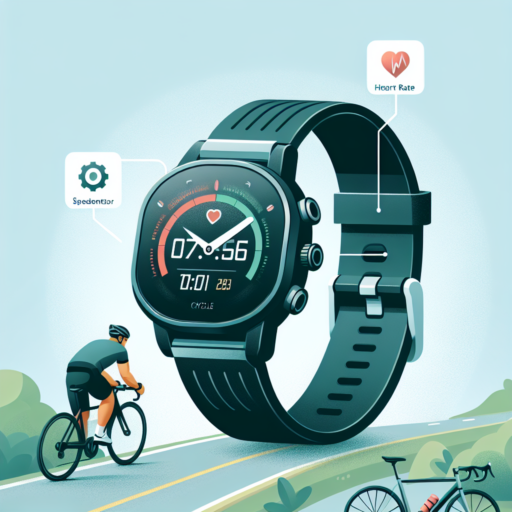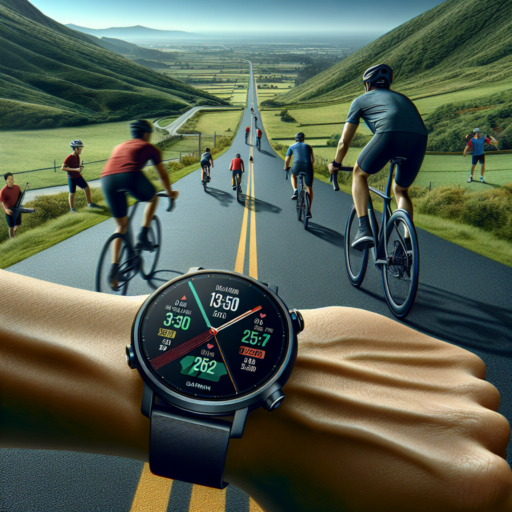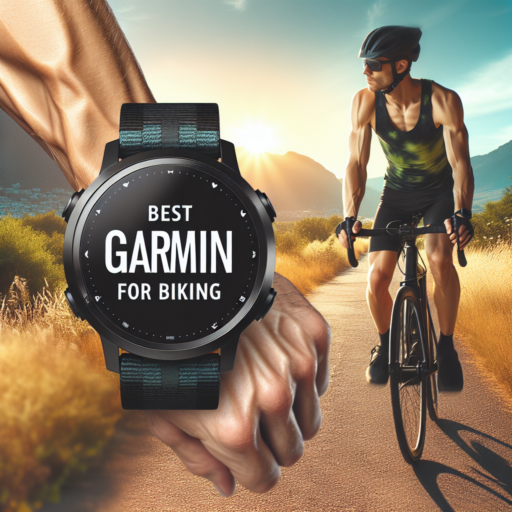What is a Cycling Watch and Why You Need One
A cycling watch is much more than a simple device for telling time; it is an essential tool designed specifically for cyclists. It integrates advanced features tailored to enhance your cycling experience, whether you’re a professional racer or a recreational enthusiast. These watches come equipped with a plethora of functionalities, including GPS tracking, heart rate monitoring, speed, and distance measurement, amongst others, providing invaluable insights into your rides.
The importance of owning a cycling watch cannot be overstated. Firstly, it offers the convenience of tracking your performance metrics in real-time, allowing for immediate adjustments in your effort or speed to meet your training goals. Moreover, the ability to monitor your heart rate and caloric expenditure aids in managing your physical exertion, ensuring a safe and effective workout. Additionally, GPS functionality not only tracks your route but also assists in navigation, proving indispensable on unfamiliar trails or long-distance routes.
Key Features to Look For
- GPS Tracking: Essential for route navigation and tracking your ride’s distance and speed.
- Heart Rate Monitor: Offers insights into your cardiovascular effort and fitness level.
- Connectivity: Wireless syncing with smartphones and cycling computers for data analysis and sharing.
In summary, a cycling watch elevates your riding experience by providing a comprehensive overview of your performance and health metrics. It’s a multifunctional gadget that serves not only as a fitness tracker but also as a navigational aid, making it an indispensable tool for every cyclist seeking to optimize their training and enhance their overall riding experience.
No se han encontrado productos.
Top Features to Look for in a Cycling Watch
When considering a cycling watch, the multitude of available options and features can be overwhelming. However, focusing on a few key features can significantly enhance your riding experience. Distinguishing the vital functions from the nice-to-have ones is crucial in making an informed decision.
GPS Functionality
One indispensable feature of a cycling watch is GPS functionality. This feature not only tracks your route accurately but also measures your speed and distance covered. Having a built-in GPS can help cyclists navigate unfamiliar routes with ease and review their ride statistics for training purposes.
Heart Rate Monitoring
Another essential feature is heart rate monitoring. This enables cyclists to train within specific heart rate zones, optimizing their effort and improving endurance over time. A watch that offers real-time heart rate data can become an invaluable tool for serious cyclists looking to enhance their physical performance.
Water Resistance and Battery Life
Lastly, look for a cycling watch that boasts solid water resistance and long battery life. Given the nature of cycling, where you can encounter various weather conditions, a water-resistant watch ensures durability. Moreover, long battery life is fundamental; it should last through your longest rides without the need for frequent recharging.
Comparing the Best Cycling Watches for 2023
When it comes to enhancing your cycling experience in 2023, selecting the right watch can make all the difference. The top cycling watches now offer a blend of sophisticated GPS navigation, detailed performance metrics, and comprehensive health tracking to support athletes of all levels. This comparison aims to guide you through the top contenders on the market, focusing on their notable features, accuracy, and overall functionality to ensure you make an informed choice.
Key Features to Look For
In evaluating the best cycling watches for 2023, several key features stand out. Most importantly, accurate GPS is essential for tracking your routes and performance. Another critical aspect is the ability to monitor heart rate, which offers insights into your training intensity and overall cardiovascular health. Additionally, battery life becomes a vital consideration, especially for long-distance cyclists who spend extended periods on the road. Other sought-after features include elevation tracking, VO2 max estimates, and smart connectivity that allows for syncing with other devices.
Top Picks for Various Cyclist Needs
Understanding that cyclists have varying needs and preferences, our comparison highlights watches that cater to different aspects of cycling. For those focused on fitness, watches offering in-depth health data prove to be invaluable. Meanwhile, adventure cyclists might prioritize rugged designs with advanced navigation features. Importantly, features like water resistance, ease of use, and the ability to display call and text notifications directly on the watch face, are also considered to cater to the modern cyclist’s lifestyle. Whether you’re training for a race or enjoying scenic routes, there’s a watch designed to meet your requirements.
How to Use Your Cycling Watch to Improve Performance
Optimizing your cycling performance involves more than just persistent training; it requires the intelligent use of technology. Among the plethora of gadgets available, a cycling watch stands out as a crucial tool for athletes looking to elevate their game. Understanding how to leverage this device can unlock significant improvements in your cycling metrics, contributing to a more efficient and effective training regime.
Setting Realistic Goals is the first step towards improving performance with your cycling watch. By analyzing your current metrics, such as average speed, heart rate, and power output, you can set achievable targets for yourself. Use your cycling watch to monitor your progress during rides and adjust your goals as you improve, ensuring they always push you to the next level.
Tracking and Analyzing Your Rides
One of the most powerful features of a cycling watch is its ability to track and store detailed data from each ride. This data provides invaluable insights into your performance over time. Regularly review your ride summaries to identify patterns or areas requiring improvement. By focusing on specific metrics, such as cadence or elevation gained, you can tailor your training to address weaknesses and amplify your strengths.
Incorporating Interval Training with the help of your cycling watch can revolutionize your training sessions. Most cycling watches come equipped with a timer and heart rate monitor, making them perfect for interval training—a proven method to increase both speed and endurance. Set up custom intervals on your watch, and use these sessions to focus on maintaining or increasing your power output over short bursts, with rest periods in between. This will help build your aerobic and anaeracic capacities, directly impacting your overall cycling performance.
Setting Up Your Cycling Watch: A Step-by-Step Guide
Getting your cycling watch ready for action is a crucial step for any cyclist, beginner or seasoned. A well-set-up device can significantly enhance your training sessions, rides, and overall monitoring of your progress and health. To make the process smoother, we have compiled an easy, step-by-step guide that walks you through the key settings and customizations for your new gadget.
Choosing the Right Display Settings
The display is your window to all the valuable data your cycling watch offers during your rides. Start by selecting what data fields are most important to you. Common choices include speed, distance, heart rate, and cadence. Most cycling watches allow you to customize these fields to ensure you see the most pertinent information at a glance. Don’t forget to adjust the brightness and font size for readability under different lighting conditions.
Setting Up GPS Functionality
GPS tracking is a key feature for any cycling watch, enabling you to monitor your route, distance, and even elevation changes. Initially, ensure your watch’s GPS is activated and check if it requires any updates. This is a one-time setup for most devices but crucial for accurate data. Experiment with the different GPS modes available to find the right balance between accuracy and battery life, especially if you plan long rides.
After configuring the basic settings, delve into the personalization options. Set your time zones manually if you travel frequently, or adjust alarms and notifications to keep you informed but not distracted. Remember, the goal is to tailor your cycling watch to fit your training and lifestyle needs perfectly. With these steps, your watch will not only be a tool for tracking but an integral part of your cycling journey.
Battery Life and Durability: What Matters Most for Cycling Watches
When it comes to selecting the perfect cycling watch, two features stand out in terms of their importance: battery life and durability. These characteristics are pivotal as they directly impact the usability and longevity of your device during rides. Whether you’re an avid cyclist training for an upcoming event or a casual rider enjoying scenic routes, understanding how these factors contribute to your device’s performance is key.
The battery life of a cycling watch determines how long you can track your rides without needing a recharge. For long-distance cyclists, a watch with an extended battery life is indispensable. It ensures that no matter the distance, your watch keeps track of your performance, route, and vital health metrics without the risk of shutting down midway. Consequently, when evaluating options, checking the estimated battery life under various modes, such as GPS tracking and heart rate monitoring, can offer significant insight into the device’s endurance.
Meanwhile, the durability of a cycling watch encompasses its ability to withstand the elements and the rigors of outdoor activities. This includes resistance to water, dust, and shocks. A durable watch not only survives the occasional bumps and scrapes but also remains functional in varying weather conditions, from rainstorms to sweltering heat waves. Thus, looking for certifications or ratings such as IP68 or MIL-STD-810G can provide an understanding of how well the watch will hold up over time and under different environmental stresses.
Integrating Your Cycling Watch with Other Fitness Apps
Integrating your cycling watch with other fitness apps is a game-changer for athletes and cycling enthusiasts alike. This seamless connection allows for a comprehensive overview of your physical activities, enabling you to track, analyze, and optimize your training sessions. By harnessing the power of app integration, users can unlock a plethora of metrics that go beyond the basics of time and distance.
One of the prime benefits of this integration is the ability to compare performances across different platforms. Users can sync their cycling data with apps that specialize in heart rate monitoring, elevation gain, and calorie tracking. This cross-app data analysis offers a multi-faceted view of your fitness progress, making it easier to set realistic goals and identify areas for improvement.
To get started, most cycling watches come equipped with built-in features designed to facilitate easy app integration. Look for the compatibility features in your device settings and follow the prompts to connect with popular fitness apps like Strava, Garmin Connect, or MyFitnessPal. This initial step opens up a world of possibilities, from joining global cycling challenges to receiving personalized training plans based on your performance data.
Cycling Watch vs. Smartphone Apps: Which is Better for Your Ride?
Choosing between a cycling watch and smartphone apps for tracking your rides is a decision that depends on multiple factors, including your training goals, the metrics you want to track, and your budget. Each option offers its unique advantages and might cater to different types of cyclists. Let’s delve into the specifics to understand which could be better for enhancing your cycling experience.
Accuracy and Performance Metrics
When it comes to tracking your ride, accuracy is key. Cycling watches are specifically designed for athletes, offering precision in metrics such as heart rate, GPS tracking, elevation gained, and more. Unlike smartphones, they are built to provide more reliable data, especially in areas with poor GPS reception. On the other hand, smartphone apps can be incredibly convenient and offer a broad range of metrics that can be sufficient for casual riders or those who don’t want to invest in an additional piece of equipment.
Convenience vs. Durability
A major factor to consider is the convenience of carrying your device. Smartphones are devices we carry daily, and using them with a mount on your bike can seem like an easy choice. However, cycling watches are designed to be robust, often waterproof, and provide easy access to your data at a glance, making them potentially more suited for rugged rides. The durability and specialized design of cycling watches provide an edge over smartphones, particularly for long-distance cyclists and those training in varied weather conditions.
Ultimately, the choice between using a cycling watch or smartphone app depends on the personal preferences of the cyclist. Whether you prioritize detailed performance metrics, the convenience of using a device you already own, or the durability and specialized features of a cycling watch, it’s essential to consider how each option aligns with your cycling goals and lifestyle.
Understanding GPS Accuracy in Cycling Watches
When it comes to optimizing cycling performance, the role of GPS accuracy in cycling watches cannot be overstated. These devices offer cyclists a way to meticulously track their rides, monitor progress, and navigate routes with greater precision. However, understanding the factors that influence GPS accuracy is essential for making the most out of this technology.
One significant aspect affecting GPS accuracy in cycling watches is the quality of the GPS chip inside the device. Higher-end watches typically feature more advanced chips that can communicate more effectively with satellites, thus providing more accurate data. Additionally, the watch’s ability to connect to multiple satellite systems (such as GPS, GLONASS, and Galileo) can also enhance location tracking accuracy.
Environmental factors play a crucial role in determining the accuracy of GPS in cycling watches. Urban canyons, dense forests, and high mountains can obstruct the line of sight to satellites, leading to potential inaccuracies. Savvy cyclists will benefit from understanding these limitations and planning routes that minimize potential disruptions to GPS signals. Moreover, regular software updates provided by manufacturers can improve the watch’s algorithm, leading to more accurate GPS data over time.
Personalizing Your Cycling Watch: Tips and Tricks
Customizing your cycling watch can significantly enhance your biking experience by tailoring its functionality to meet your specific needs. Whether you are a seasoned cyclist or just getting into the sport, a few simple adjustments can make a world of difference. From setting up your display to choosing the right apps, the possibilities for personalization are endless.
Adjusting Display Settings for Optimal Viewing
One of the first steps in personalizing your cycling watch is to adjust the display settings to suit your preferences. This might include changing the data screens to show your most used metrics, such as speed, distance, and heart rate, at a glance. Brightness levels and backlight duration can also be tweaked to ensure your watch is easy to read in any lighting condition, without draining the battery unnecessarily.
Choosing the Right Apps and Widgets
Another aspect of customization involves selecting the apps and widgets that best complement your cycling routine. Many cycling watches come with a range of pre-installed applications designed to track performance, navigate routes, and even monitor weather conditions. However, exploring the available app market can reveal additional options that might be more aligned with your personal goals and interests, such as interval training timers or nutrition trackers.
Ultimately, the key to effectively personalizing your cycling watch lies in exploring all the features available and experimenting with different settings until you find the perfect setup for your rides. Remember, what works for one cyclist might not work for another, so don’t be afraid to try out various configurations to discover what enhances your cycling experience the most.




